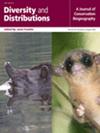Anthropogenic Pressures Lead to Different Patterns of Niche Contraction and Protected Area Cover in Three Species Procapra Gazelles on Qinghai-Tibet Plateau and Mongolia
Abstract
Aim
Anthropogenic threats often lead to range contraction towards the margins of a species historic niche, resulting in increased extinction risk. Here, we investigate niche characteristics of current and historic populations to evaluate changes in ‘Area of Niche’ (AON) following range loss from different levels of anthropogenic threats three congeneric Asian gazelle species are facing: Przewalski's (Procapra przewalskii), Tibetan (P. picticaudata) and Mongolian gazelles (P. gutturosa).
Location
Tibet, Qinghai and Mongolia.
Methods
We collated range maps for historic and contemporary distributions of Przewalski's, Tibetan and Mongolian gazelles and created 3-dimensional hypervolume and convex hull niche models using environmental variables from the Worldclim dataset (v2) together with topographic information from SRTM elevation data from historic and contemporary Area of Habitat maps and evaluated changes over time. We calculated Area of Niche (AON) maps by projecting a scaled Mahalanobis distance from the historic niche centroid of each grid cell onto each species' historic range. Finally, we evaluated how the protected area network overlaps with historic niche characteristics.
Results
The endangered Przewalski's gazelle has lost almost all its range and niche, with remaining populations at niche peripheries. In contrast, the near-threatened Tibetan and least-concern Mongolian gazelles have lost less range and niche and contracted towards their historic niche centre. Protected areas for each species were biased towards the ecological margins of their historic ranges, which can result in sub-optimal conservation strategies.
Main Conclusions
This study uses niche modelling to evaluate changes in Area of Niche (AON) occupied by a species that has undergone range contraction. We highlight that species most affected by anthropogenic threats are most vulnerable to niche shift and contraction. These species are also vulnerable to a mismatch between the protected area network and species historic niche space. We advocate that conservation strategies should include niche dynamics as an indicator of the species risk.


 求助内容:
求助内容: 应助结果提醒方式:
应助结果提醒方式:


